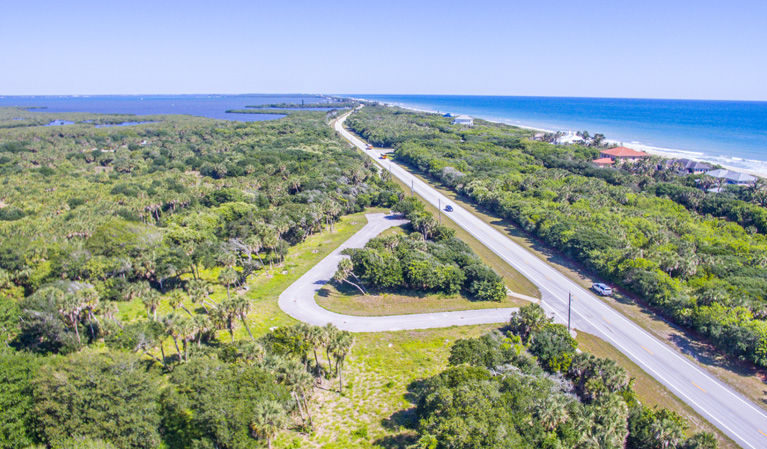
A site on the north barrier island where an architect dreamed of building luxury homes with rooftop swimming pools overlooking a pristine wildlife preserve remains in limbo eight years after the project faltered, an eyesore with a future fate unknown.
The Great Recession left Florida littered with foreclosed subdivisions and never-realized housing projects where vacant lots and desolate streets overgrown with weeds serve as a sad legacy of the corruption, greed and speculative mania that fueled the biggest housing bust in history.
There was far less of this on the barrier island than elsewhere in Florida – with housing and lot prices here now back above their pre-2007 levels – but this particular 3.71-acre failed subdivision is no ordinary empty property.
Subdivided into 10 lots a stone’s throw off of A1A, the site abuts the famed Pelican Island National Wildlife Refuge, the nation’s first wildlife refuge founded in 1903. President Theodore Roosevelt created the sanctuary because plume hunters were wiping out birds such as egrets. Nowadays, 15,000 birders and other nature aficionados enjoy the serene haven annually.
But besides exotic birds, visitors may come across a silent concrete street called Brown Pelican Way lined with land mostly cleared of trees on the west side of A1A – a visual gouge into the thick collection of native upland plants and protected trees.
Despite the pavement, utility boxes and plated lots, no housing was ever built after the former developer, Paskor, LLC of Toronto, won approval for the project from the Indian River County Planning and Zoning Commission in 2005.
Engineer John Blum, of Carter Associates in Vero Beach, recalled the project’s partners were architect and developer Attila Hollohazy of Toronto and Amile Korangy, a Maryland physician, who owned a chain of radiology centers in the Baltimore area.
After the development faltered, PNC foreclosed on the mortgage it held on the land, and the lender is still waiting for a buyer to come along so it can recoup its investment, said Vero Beach lawyer Michael O’Haire, who represented Hollohazy during the permitting and approval process.
“It’s just sitting there having been foreclosed,” O’Haire told Vero Beach 32963. O’Haire said he quit the project after not getting paid.
Auction Company of America in Miami auctioned off the acreage in December 2014 after the developer filed for bankruptcy in Maryland. The winning bid was $852,500, said auctioneer Jim Gall, who owns Auction Company of America. O’Haire said the sole bidder was project lender PNC. A PNC spokeswoman said the company doesn’t comment on foreclosures.
Six months later, in May 2015, Bancshares, LLC bought the land for $515,100, according to county property appraiser records. O’Haire said Bancshares is affiliated with PNC. Bancshares could not be reached for comment.
O’Haire believes the current owner will not sell or develop the property until the investment can be recouped – which may be a long wait.
The subdivision plan seems to have been ill-starred from the start.
More than a decade ago, before the county approved the 10-lot subdivision, Indian River planners advised Paskor, LLC to try and sell the land to the federal government as a natural extension of the Pelican Island refuge, said John McCoy, chief of the county’s current development planning section.
“It’s a little out of place,” McCoy said in an interview at the county planning department. “It’s an odd place [for a 10-lot subdivision] and an odd proposal.”
One “odd” feature to the proposed houses, recalled Blum, the project’s former engineer, was the idea of having rooftop pools.
County staff had recommended Paskor cluster the housing units and create “large open space, native conservation areas,” county planning official Stan Boling wrote in a July 8, 2005, memorandum to the planning and zoning commission.
But Paskor declined and forged ahead with a conventional subdivision plan that wiped out 70 percent to 90 percent of the protected trees on site, according to county records.
“Because the site is less than five acres in size, the county’s native upland set-aside requirement does not apply,” Boling wrote in that 2005 memo.
Hollohazy, who designed the layout, was upset the county would not allow him to build multifamily housing, so he submitted a plan that maximized the number of house lots on the site, Blum recalled. The required minimum lot size was 12,000 square feet and the proposed lots came in at 12,026 square feet, records show.
Hollohazy did negotiate with the federal government to designate the site’s west side as a buffer and conservation easement. In return for receiving the conservation easement, the refuge granted the developer drainage rights in the wildlife haven.
Those rights were never exercised though, as no homes were ever built.
“After 2008, after the housing industry collapsed, that’s when the project was stopped and we never heard from Hollohazy,” said Blum.
These days, the federal government has no interest in trying to buy the property because “it doesn’t have any natural resource value for us because of the road and most of the land has been heavily disturbed from making it into a subdivision,” said Oliver van den Ende, a restoration coordinator who works at several federal sites including the Pelican Island National Wildlife Refuge.
The refuge is not interested in using land for building purposes because it’s already building an office and residence next to Wildlife Way, a narrow dirt road off A1A, van den Ende said.
Vero Beach 32963 was not able to reach Hollohazy for comment.



